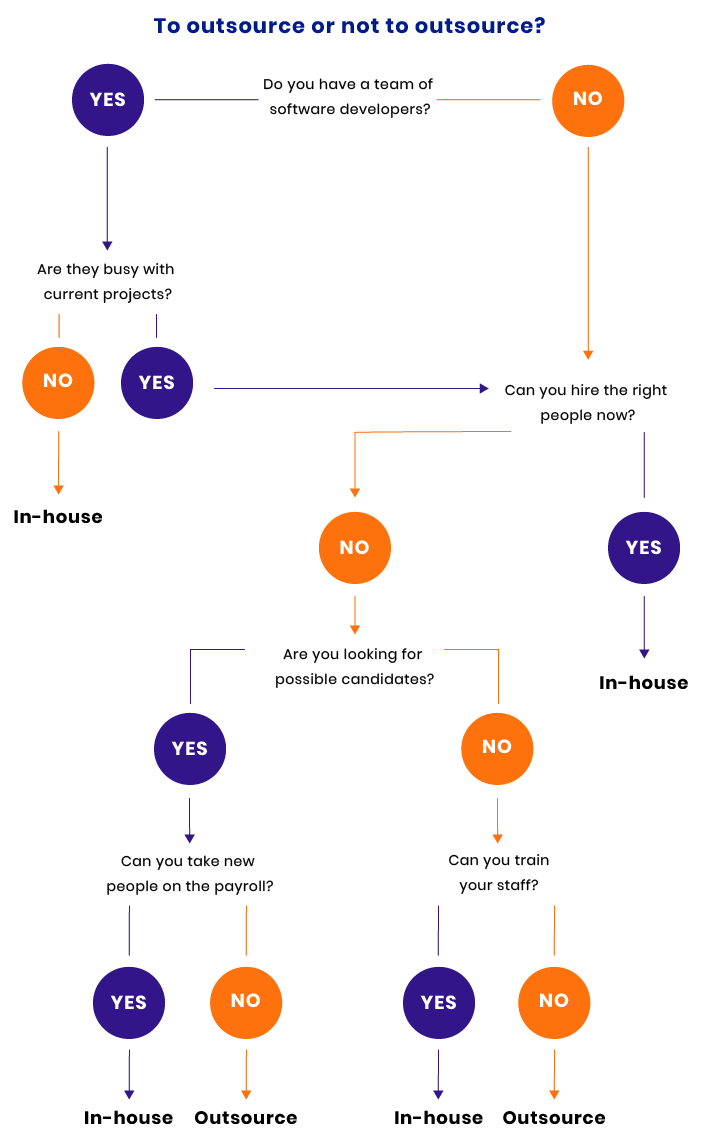-
Product Management
Software Testing
Technology Consulting
-
Multi-Vendor Marketplace
Online StoreCreate an online store with unique design and features at minimal cost using our MarketAge solutionCustom MarketplaceGet a unique, scalable, and cost-effective online marketplace with minimum time to marketTelemedicine SoftwareGet a cost-efficient, HIPAA-compliant telemedicine solution tailored to your facility's requirementsChat AppGet a customizable chat solution to connect users across multiple apps and platformsCustom Booking SystemImprove your business operations and expand to new markets with our appointment booking solutionVideo ConferencingAdjust our video conferencing solution for your business needsFor EnterpriseScale, automate, and improve business processes in your enterprise with our custom software solutionsFor StartupsTurn your startup ideas into viable, value-driven, and commercially successful software solutions -
-
- Case Studies
- Blog
Software Development: In-house or Outsourced?
If you’re reading this article, you’re probably in search of a way to build a software product. And you’re probably choosing between in-house vs. outsourced software development. Whether you’re a startup or an experienced company, you want to build your product fast, keep the quality high, and keep the costs low. Have you found the answer for how to do that? It might look impossible to get all three things with one approach. The solution is choosing the right team: in-house developers vs an outsourcing company.
It’s hard to recommend one approach for all cases, as every software project has its own requirements and factors to consider. Below, you’ll find the pros and cons of these two approaches to software development and some advice on which to choose.
In-house team
In-house development has always been in favor among CEOs. In-house is when you build a team from your own employees and assign them to the project. The first argument in favor of an in-house team is that you can gather trusted people who share your views and are dedicated to your company around you. It makes sense to build an in-house team for your main projects and for activities you perform on a daily basis. Your in-house team is the core of your company. If you’re a pure IT company, you need to find real gems in order to succeed.
Companies that do it in-house:
- PayPal makes use of the in-house approach to provide the highest quality products all around the world.
- Amazon has in-house employees handle most business processes in order not to reveal any development secrets.
- Salesforce is a top-notch CRM system that chose in-house over outsourced software development for its projects.
Pros of an in-house team
Direct access to your employees. With an in-house team, you know the abilities of every team member and can assign them tasks accordingly. If you have an issue, you’ll know who caused it and that it will be resolved quickly. Urgent tasks and fixes can always be prioritized by your in-house team, while an outsourced team you once worked with might be engaged in another project at the moment.
Ability to build a company culture. If you’re a startup, it’s important to outline a strict workflow and develop corporate ethics, codes, events, etc. from the very beginning. Team spirit is something you’ll never have with an outsourced team. People’s relationships influence how products are created and, consequently, the final result.
Personal involvement. Call it a psychological effect, but it works: an in-house team has a sense of fellowship and engagement in the company’s activities. This cooperation is rewarding not only for you but for your team. They’ll be proud of developing and implementing new technology, causing endorphins to kick in and resulting in job satisfaction. It makes your employees passionate, loyal, and productive. What’s more, an engaged team will constantly seek out bugs to eliminate and find things to upgrade to improve your company.
Expertise in your company’s profile. When you are your own client, it’s easier to comply with your requirements. You don’t need to spend hours explaining to contractors what you want done and how. An understanding of a company’s philosophy, ethics, position on the market, and even cultural peculiarities are crucial for the best performance. People who possess corporate knowledge will be able to solve issues more easily than an outsourced worker.
Cons of an in-house team
High cost. Payroll. This word is a headache for companies. Having employees on the payroll means paying them no matter what. Whether they’re working on a big project or making small changes to support a product’s performance, you have to pay the same salary. Moreover, it’s your task to provide benefits such as health insurance, vacation days and sick pay, corporate events, free meals, and equipment. On top of this, you have to pay your developers even if they’re on the bench because they don’t have a project at the moment. Your task is to keep them interested and retain them. So you either have to find generous investors or keep you business basic.
Team management and hiring are handled by you. While a service provider takes care of outsourced developers, the in-house approach gets you involved in this tiresome process. Managing your team can keep you busy and constantly distract you from your main tasks. Finding the people who will make a long-term commitment to your company and onboarding them might seem like a never-ending process.
Lack of versatility. If you’re an IT company, you might want to occupy only one niche: Ruby on Rails, mobile development, web, etc. This means your employees will be experienced in one area only. They might ace one or two programming tools but have a poor command of others. The IT sphere is constantly changing, and you have to offer different products to remain profitable. If you decide to launch a brand-new product with an unknown technology, you’ll have to employ a professional or enroll your employees in courses. This leads us to the next disadvantage of such a method.
Investment in skills development. So you have a team. A team of people with diverse knowledge and experience that’s either too little or inapplicable in most cases. What’s your next move? Training. Building a professional, well-qualified team in-house takes a lot of time, money, and effort. If you’re a startup, it will take months because you’re doing it from scratch.
Updating employees’ skills is an ongoing process. If you want to keep up with the market, provide your employees with training opportunities. At the start, you’ll have to cover the cost partially or organize company-wide training, which might be a more cost-efficient solution. Without proper training, your company’s performance will remain at the same level. On the other hand, as soon as your employees have mastered new skills, they can mentor newcomers and you’ll reduce the costs of training.
When to develop in-house
To see if in-house development fits your needs, just answer a few questions:
- Do you want to maintain full control of your projects?
- Do you want to have a unique and outstanding product that meets all your expectations?
- Do you have to wait days until bugs are fixed?
- Do you want to keep your product updated and optimized?
If you answered yes to all of these questions, opt for an in-house team. Follow our recommendations, invest in your employees, and build an empire. One more piece of advice: make sure your employees aren’t all beginners; otherwise, you’ll lose even more time waiting for them to build up their skills.
Outsourced team
This approach isn’t new to the IT sphere. Whereas seven years ago outsourcing was seen as a big risk, nowadays it’s a common practice. There are many lists of trusted outsourcing companies, and more companies emerge on the market daily. The numbers speak for themselves: the revenue of the global outsourcing market has almost doubled in size since 2000. Take a look at the statistics below.

It may seem that companies outsource only to cut costs, but that’s not the only reason. It has a lot to do with accessing the global talent pool. Below, you’ll find other advantages of outsourcing software development.
Companies that outsource:
- Alibaba, a global marketplace, couldn’t exist without an outsourced team who takes care of backend development.
- Google is not a newcomer to outsourcing. They successfully outsource small parts of their work to external vendors.
- Slack worked with MetaLab, a design firm based in Canada, to design their web interface.
- Skype and GitHub were two aspiring startups that have evolved into successful companies with global outsourced teams.
Pros of an outsourced team
Cost-efficiency. We know this is a controversial advantage and is not always the top priority, but money still matters, especially if you’re at square one.
Take a look at the table below to see average yearly software developer salaries as of 30 April 2019.

As you can see, there are various countries with competitive rates in comparison to those in the US. All you need to do is choose a country in your price range and look for developers with decent portfolios and references.
Another thing to consider is that outsourcing is a short-term cooperation, and you pay the vendor only once. Maybe twice if you need a follow-up. On top of that, you don’t have additional expenses you would have with an in-house team, such as training for a particular project or buying additional hardware and software.
No recruitment hassle. While working with a vendor, this advantage really stands out. You may know how tough it is to build a team from scratch. You have to not only find people with the perfect skill set but also attract them offering a decent salary and working conditions. Then there’s onboarding and mentoring. Both are effort- and cost-consuming. Don’t be deceived if it seems that you only need to pay the recruiters. To find top talent fast, you need to build a good name for your brand, which includes additional expenses for marketing. This isn’t generally a problem for household brands, but it might be a long-lasting challenge for startups. Why bother with all of this if professional vendors provide a full range of services along with risk management?
Get the expertise that you lack. One of the most appealing advantages of outsourcing is access to an almost unlimited talent pool from all over the world. A specialist from any country with any expertise will eagerly start working for you if your offer corresponds with their expectations. Outsourcing is a rich source of fresh ideas and innovation for creative projects. Remote employees don’t have blurred vision and can also add a hint of their culture to make your product unique and multi-faceted. This is additionally important if you develop an international app or website.
Outsourcing companies have a wide range of experts in various technologies, so you’ll always have contractors for your projects. What’s more, as the competition on the outsourcing market is tough, companies are always improving the performance and sets of skills their developers have.
Focus on your urgent tasks. Stick to the motto, Do what you’re best at and outsource the rest. This will help you manage tasks and avoid failures. Leave all the development routine and issues to your outsourced team. When you’ve found the right people for your project, you’ll have plenty of time on your hands. You can devote it to planning your budget, working on urgent questions, building a marketing strategy, etc.
Free up your in-house team so they can focus on long-term tasks or your projects that are already under way.
Cons of outsourced teams
Obviously, there are certain limitations that come with outsourced teams.
You aren’t in direct control and/or can’t reach the team in person. This might be a challenge for newcomers, as you aren’t where things are happening. You can’t see a problem coming. You can’t gather a meeting in 20 minutes. You might have trust issues and think that you could do it better yourself. Transparency isn’t a strength of such an approach. But you can track your team’s progress using modern software and management approaches.
Different time zones. This is often seen as a major issue when working with a remote team. Time zone differences can create delays in communication and delivery. It may be an obstacle when you want to arrange meetings. But look at it this way: if you have a large time gap with your contractors, it means that your company can work 24/7. If your company is based in New York, an outsourced team in the Eastern Hemisphere is literally in the future and can finish before your deadline. Moreover, if you hire nearshore, the difference won’t be so large and you might also have similar cultures and mentality.
Security threat. There are certain risks connected to confidentiality and project details. There have been cases of disclosure of companies’ secrets and confidential project data. While there still are companies with unreliable employees, nowadays you have fewer chances of stumbling upon them.
It’s so easy to check the reputation of a vendor or freelancer. You can quickly find their portfolio, read references and reviews of their work, and likely find their blog.
As trustworthy directories of outsourcing companies, we recommend Clutch, DesignRush, GoodFirms, and GROWlabs. On these websites, you can filter vendors by location, industry, hourly rate, and even number of employees. Whatever fits your taste. In any case, a well-structured and all-inclusive contract will prevent potential issues with your team.
Commitment. Finally, outsourced developers might not share the excitement you have about your project. For you, it might be your first big project and you want it to happen so badly; but for the team, it’s just another task they have to fulfill. Your expectations about their output may not align with reality due to a lack of personal engagement.
To avoid this, provide an insight into your company at your first meeting and share your values and mission. The more your team knows about your company, the more interested they’ll be in your project.
When to outsource
Outsourcing fits perfectly if your company doesn’t specialize in software development and your new project is supplementary. Moreover, if you know nothing about software development, opt for outsourcing, as in-house development requires thorough planning and precise management.
On the other hand, if you’re an IT company, outsourcing can also work for you. Choose it if your internal team has too many priority tasks on their hands.
Another reason to outsource is to bring some innovation and fresh ideas to your enterprise. You may consider hiring only crucial team members to supplement your core team. If you can afford only one developer in-house for the project, it’s better to opt for an outsourced team with wider expertise.
Summing up
If you choose wisely and take all the facts into consideration before starting development, you’ll avoid the pitfalls of any approach, be it in-house or outsourced software development. Both options have their pros and cons, so examine your needs, goals, and budget in order to make the right decision.

If you’re looking at things in the long-term perspective, build a strong in-house team. If you’re a newcomer on a low budget, try making an MVP with an outsourced team to see if it works. Outsourcing development isn’t something you should be scared of even if it’s your first time.












